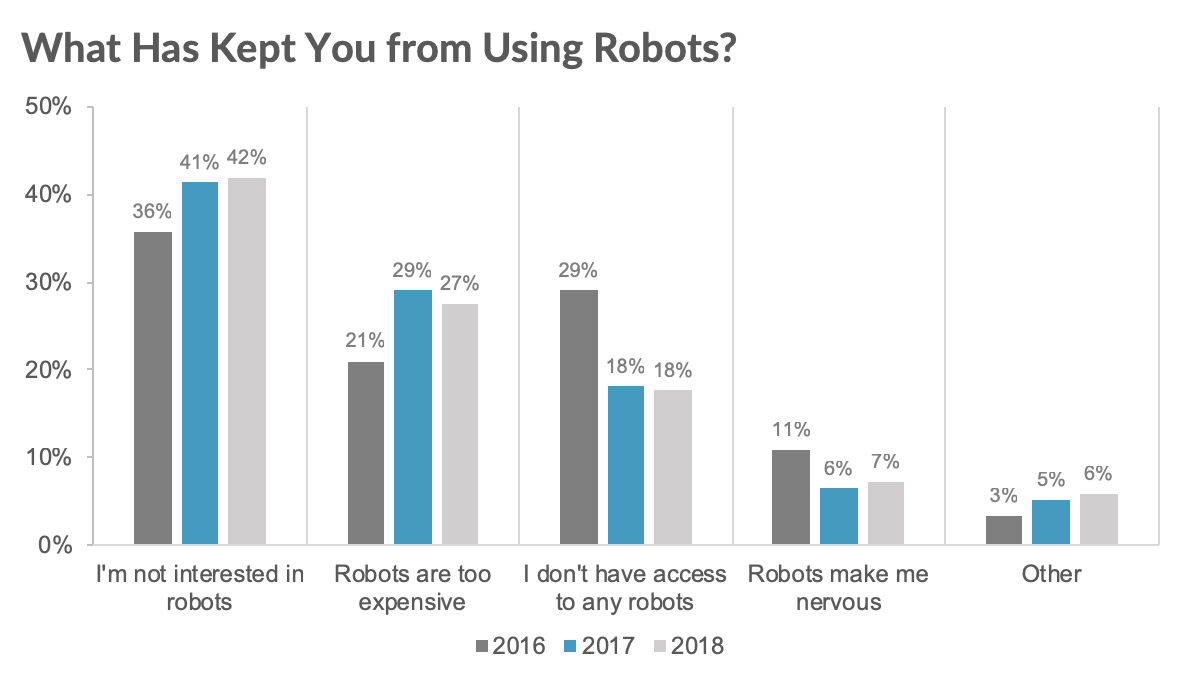Like many in the tech space, we believe robotics is changing the nature of work. However, public perception of robots is still a question mark. We developed our Robot Fear Index to measure and track the average consumer’s perception of robots. We asked over 400 US consumers about topics ranging from their use of robots at home to their comfort level with self-driving cars. Then we distilled the data down to an index value that we will publish regularly. An index value of 100 suggests widespread and extreme fear of robots; an index value of 0 suggests minimal fear of robots.
Consumer adoption of artificial intelligence and robotics is already quite broad, and yet, fear of robots is pervasive as well. We fear that they’ll replace our jobs or somehow overthrow us, and those fears are valid. Our 2018 survey tells us that the shift in consumer acceptance needed for widespread adoption may take longer than anticipated. In the tech echo chamber, it is easy to be convinced that once something is technologically feasible, it will be rapidly adopted. However, we are constantly served small reminders that broad shifts take longer than we expect.
Our most recent Robot Fear Index value of 31.8 (vs 30.9 in 2017 and 31.5 in 2016) suggests that public perception of robots is essentially unchanged over the last two years. Our survey suggests two countervailing factors:
- Increased adoption of automation technology
- Growing awareness of the potential risks of automation
When Siri or Google Assistant, for example, accurately predicts that you’re about to drive home, text a certain contact, or check a particular stock price, there’s a “fear” factor associated with that. The more we use these predictive products, the spookier they get. But, at the same time, they become more useful.
Survey Details
Of the 415 survey respondents, 53% were female and 47% were male. Our survey population was more or less equally weighted across all age groups excluding kids under the age of 18. It is worth noting that the largest group of survey respondents was over the age of 60 (also the case in 2017). This, understandably, can skew responses toward less comfort with and usage of robots.
Use of Digital Assistants Continues to Grow
We see the use of digital assistants as an onramp to further usage of AI and robotics for many consumers. This year’s survey shows that 70% of people have used a digital assistant, and 23% use one multiple times per day. Overall, frequent use of digital assistants is up, with 33% of respondents using one at least once a day. When asked about digital assistant ownership, 40% of respondents said they own at least one, and 9% own 3 or more.

Comfort with Robots Unchanged
Compared to last year, people are less comfortable with 4 of the 8 robot use cases we track, more comfortable with 3 of them, and 1 has remained unchanged. Compared to two years ago, all use cases have trended more comfortable or neutral, except in healthcare. Little can be inferred from such small shifts. However, rather than looking at trends, three years of data gives us a good picture of which use cases people are comfortable with overall and which they continue to push away from. Shopping, digital assistants, and house cleaning continue to be the most acceptable activities, which we attribute to the fact that there are already tangible use cases on the market today. Meanwhile, healthcare (e.g., a surgical robot) and travel (e.g., self-driving cars) incite discomfort, which may be because they sound inherently dangerous to one’s personal safety.

What is Keeping Consumers from Using Robots?
When asked what has kept respondents from using robots, 42% said they were simply not interested (up from 41% a year ago), and 27% (down from 29%) said they were too expensive. It’s notable that these numbers remain essentially unchanged; in other words, where we may expect to see interest in robotics and automation rising, we are not.

When asked when will AI and robotics cause significant job loss, 28% said within 5 years, 29% inside 10 years, 20% inside 20 years, and 4% inside 40 years. The remaining 19% did not believe robots would ever cause significant job loss.
Bottom Line
Following our 2017 and 2016 Robot Fear Index surveys, consumer fear of robots appears to be essentially unchanged. We see two countervailing factors: increased adoption, and growing awareness. In fact, the first trend may even be fueling the second, resulting in a net-neutral viewpoint on robotics. We think our index value of 31.8 quantifies this cautious comfort with robots and we’re looking forward to updating the Robot Fear Index regularly as we track the progress of the robotics theme.
Disclaimer: We actively write about the themes in which we invest or may invest: virtual reality, augmented reality, artificial intelligence, and robotics. From time to time, we may write about companies that are in our portfolio. As managers of the portfolio, we may earn carried interest, management fees or other compensation from such portfolio. Content on this site including opinions on specific themes in technology, market estimates, and estimates and commentary regarding publicly traded or private companies is not intended for use in making any investment decisions and provided solely for informational purposes. We hold no obligation to update any of our projections and the content on this site should not be relied upon. We express no warranties about any estimates or opinions we make.
